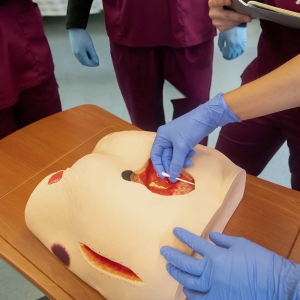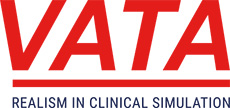Reference Guide For Disinfection in Simulation

Cleaning vs Disinfecting
Cleaning is the physical washing away of contaminants using soap and water. Disinfecting is the use of chemicals to kill germs remain- ing on a surface. Surfaces should always be cleaned before disinfecting.
EPA “List -N”
List of chemicals known by the EPA to kill contagion. This list can be focused based on what you are looking to disinfect, such as COViD.
Handwashing
Remove jewelry and rinse hands with warm running water. Use friction to lather soap entirely over both hands. Wash thoroughly under running water. Turn off faucet with wrist/elbow. Dry hands with a disposable towel or electric air dryer. If hand washing is not available: Rub an adequate amount of antiseptic hand sanitizer on all surfaces. Let the antiseptic dry on its own.
Guidelines for Cleaning Manikins
• Clean all manikins with soap and water prior to disinfecting.
• Laerdal and CAE recommend disinfecting with 70% isopropyl alcohol.
• CPR manikin faces can be disinfected with a sodium hypochlorite solution.
• Do not scrub manikin skins.
Contact Time (Dwell Time)
The amount of time a disinfectant needs to remain visibly wet on a surface to properly kill contagions; varies per manufacturer’s guidelines. Refer to EPA List N for dwell time of specific chemicals.
Best Practices for Sim Center Cleaning
Hard Surfaces: Clean with soap and water prior to disinfecting. Be sure to disinfect all commonly touched surfaces such as doorknobs, light switches, and water fountains. Follow guidelines and safety recommendations for each chemical according to the EPA’s List N.
Soft Surfaces: Launder if possible or use an approved cleaner from List N or the manufacturer.
Clothing and Fabric: Do not shake. Wash with the hottest water setting the fabric will allow. Use disposable or washable hamper liners.
Electronics
• Consider wipeable/disposable covers for touch screens and keyboards.
• Use manufacturer guidelines for cleaning. If none, use an alcohol-based cleaner of at least 70% isopropyl alcohol and allow to dry.
• Avoid bleach/alcohol/abrasives on touch screens!
Sodium Hypochlorite Solution
1⁄3 cup of bleach(1000ppm minimum) per gallon of water. Contact time 1 minute on the surface.
VR Equipment
• Use disposable covers and disinfect between users.
• Wet with 70% alcohol solution or other disinfectant and allow to completely dry.
• Do not use any cleaners on the lenses. Avoid UV light due to the potential for burning the screens.
Disinfection With UV
UV changes the structure of genetic material and prevents the replication of germs. Shading and shadowing can prevent UV light from effectively disinfecting surfaces. Caution: UV can burn your eyes and skin causing lasting damage.
Common disinfectants
• Quaternary Ammonium, the most common ingredient on List-N.
•Sodium Hypochlorite, the main ingredient in bleach.
• Hydrogen Peroxide.
• Do not mix cleaning chemicals. Always follow the manufacturer’s guidelines.
• Isopropyl Alcohol with a percentage higher than 70% will evaporate too quickly to allow it to kill contagions.
References
CDC. (2020, February 11). Coronavirus Disease 2019 (COVID-19) – Environmental Cleaning and Disinfection Recommendations. Centers for Disease Control and Prevention. https://www. cdc.gov/coronavirus/2019-ncov/prevent-getting-sick/cleaning-disinfection.html
